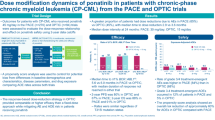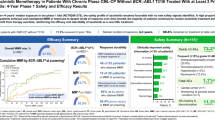Abstract
Background
Mitomycin C (MMC) up-regulates topoisomerase-I and thymidine phosphorylase making it ideal to combine with irinotecan or capecitabine. One of the most devastating toxicities MMC has been associated with is thrombotic thrombocytopenic purpura/hemolytic uremic syndrome (TTP/HUS) in 4–15% of patients, especially when receiving cumulative doses higher than 60 mg/m2.
Methods
We conducted a pooled safety analysis of 140 patients enrolled in three prospective clinical trials at our institution from 2001 to 2008. MMC on all our studies was capped to a cumulative dose of 36 mg/m2 to limit toxicity while retaining efficacy. We reviewed our electronic medical records and clinical trial database for individual patient data on these studies with a specific intent to identify patients meeting criteria for TTP/HUS.
Results
In combination with irinotecan or capecitabine, MMC was associated with manageable toxicities. We found no cases of MMC-associated TTP/HUS. There were no reported cardiac or pulmonary toxicities in our analysis. Most common grade 3/4 toxicities were diarrhea (19%), neutropenia (17%) and dehydration (12%) predominantly when MMC was combined with irinotecan.
Conclusions
In this large pooled analysis, we found MMC, when capped at a cumulative dose of 36 mg/m2, to be safe and tolerable in combination with capecitabine or irinotecan with no reportable cases of TTP/HUS.

Similar content being viewed by others
References
Edwards BK, Brown ML, Wingo PA et al (2005) Annual report to the nation on the status of cancer 1975–2002 featuring population-based trends in cancer treatment. J Natl Cancer Inst 97(19):1407–1427
Jemal A, Siegel R, Ward E et al (2008) Cancer statistics, 2008. CA Cancer J Clin 58(2):71–96
Grothey A, Sargent D, Goldberg RM, Schmoll H-J (2004) Survival of patients with advanced colorectal cancer improves with the availability of fluorouracil-leucovorin, irinotecan, and oxaliplatin in the course of treatment. J Clin Oncol 22(7):1209–1214
Lown JW, Sim SK, Chen HH (1978) Hydroxyl radical production by free and DNA-bound aminoquinone antibiotics and its role in DNA degradation. Electron spin resonance detection of hydroxyl radicals by spin trapping. Can J Biochem 56(11):1042–1047
Doll DC, Weiss RB, Issell BF (1985) Mitomycin: ten years after approval for marketing. J Clin Oncol 3(2):276–286
Bradner WT (2001) Mitomycin C: a clinical update. Cancer Treat Rev 27(1):35–50
Garewal HS, Brooks RJ, Jones SE, Miller TP (1983) Treatment of advanced breast cancer with mitomycin C combined with vinblastine or vindesine. J Clin Oncol 1(12):772–775
DeFuria MD, Bracken RB, Johnson DE et al (1980) Phase I-II study of mitomycin C topical therapy for low-grade, low stage transitional cell carcinoma of the bladder: an interim report. Cancer Treat Rep 64(2–3):225–230
Witjes JA, v d Meijden AP, Collette L et al (1998) Long-term follow-up of an EORTC randomized prospective trial comparing intravesical bacille Calmette-Guerin-RIVM and mitomycin C in superficial bladder cancer. EORTC GU Group and the Dutch South East Cooperative Urological Group. European Organisation for Research and Treatment of Cancer Genito-Urinary Tract Cancer Collaborative Group. Urology 52(3):403–410
Flam M, John M, Pajak TF et al (1996) Role of mitomycin in combination with fluorouracil and radiotherapy, and of salvage chemoradiation in the definitive nonsurgical treatment of epidermoid carcinoma of the anal canal: results of a phase III randomized intergroup study. J Clin Oncol 14(9):2527–2539
Ajani JA, Winter KA, Gunderson LL et al (2008) Fluorouracil, mitomycin, and radiotherapy vs fluorouracil, cisplatin, and radiotherapy for carcinoma of the anal canal: a randomized controlled trial. JAMA 299(16):1914–1921
Vici P, Di Lauro L, Carpano S et al (1996) Vinorelbine and mitomycin C in anthracycline-pretreated patients with advanced breast cancer. Oncology 53(1):16–18
Conti JA, Kemeny NE, Saltz LB, Andre AM, Grossano DD, Bertino JR (1995) Continuous infusion fluorouracil/leucovorin and bolus mitomycin-C as a salvage regimen for patients with advanced colorectal cancer. Cancer 75(3):769–774
Berghmans T, Gourcerol D, Lafitte JJ et al (2008) Mitomycin plus vinorelbine salvage chemotherapy in non-small cell lung cancer: a prospective study. Lung Cancer
Giuliani F, Molica S, Maiello E et al (2005) Irinotecan (CPT-11), mitomycin-C (MMC) as second-line therapy in advanced gastric cancer: a phase II study of the Gruppo Oncologico dell’ Italia Meridionale (prot. 2106). Am J Clin Oncol 28(6):581–585
Davidson NG, Davis AS, Woods J, Snooks S, Cheverton PD (1999) FILM (5-fluorouracil, ifosfamide, leucovorin and mitomycin C), an alternative chemotherapy regimen suitable for the treatment of advanced breast cancer in the ‘out-patient’ setting. Cancer Chemother Pharmacol 44(Suppl):S18–S23
Price TJ, Ross PJ, Hickish T et al (2004) Phase III study of mitomycin-C with protracted venous infusion or circadian-timed infusion of 5-fluorouracil in advanced colorectal carcinoma. Clin Colorectal Cancer 3(4):235–242
Ross P, Norman A, Cunningham D et al (1997) A prospective randomised trial of protracted venous infusion 5-fluorouracil with or without mitomycin C in advanced colorectal cancer. Ann Oncol 8(10):995–1001
Rao S, Cunningham D, Price T et al (2004) Phase II study of capecitabine and mitomycin C as first-line treatment in patients with advanced colorectal cancer. Br J Cancer 91(5):839–843
Scartozzi M, Falcone A, Pucci F et al (2006) Capecitabine and mitomycin C may be an effective treatment option for third-line chemotherapy in advanced colorectal cancer. Tumori 92(5):384–388
Verweij J, Pinedo HM (1990) Mitomycin C: mechanism of action, usefulness and limitations. Anticancer Drugs 1(1):5–13
Thomson Healthcare: Greenwood Village C. Micromedex, Micromedex Healthcare series 2007
Lesesne JB, Rothschild N, Erickson B et al (1989) Cancer-associated hemolytic-uremic syndrome: analysis of 85 cases from a national registry. J Clin Oncol 7(6):781–789
Moake JL, Byrnes JJ (1996) Thrombotic microangiopathies associated with drugs and bone marrow transplantation. Hematol Oncol Clin North Am 10(2):485–497
Liu K, Mittelman A, Sproul EE, Elias EG (1971) Renal toxicity in man treated with mitomycin C. Cancer 28(5):1314–1320
Lempert KD (1980) Haemolysis and renal impairment syndrome in patients on 5-fluorouracil and mitomycin-C. Lancet 2(8190):369–370
Fung MC, Storniolo AM, Nguyen B, Arning M, Brookfield W, Vigil J (1999) A review of hemolytic uremic syndrome in patients treated with gemcitabine therapy. Cancer 85(9):2023–2032
Zakarija A, Bennett C (2005) Drug-induced thrombotic microangiopathy. Semin Thromb Hemost 31(6):681–690
Kennedy KA, Rockwell S, Sartorelli AC (1980) Preferential activation of mitomycin C to cytotoxic metabolites by hypoxic tumor cells. Cancer Res 40(7):2356–2360
Mrozek E, Kolesar J, Young D, Allen J, Villalona-Calero M, Shapiro CL (2008) Phase II study of sequentially administered low-dose mitomycin-C (MMC) and irinotecan (CPT-11) in women with metastatic breast cancer (MBC). Ann Oncol
Miguel Villalona-Calero JK (2002) Mitomycin C as a Modulator of Irinotecan. Anticancer activity. Oncology
Villalona MA, Bekaii-Saab T, Burak W, Ross P, Xu Y, Criswell T, Duan W, Young D, Miller J, Kolesar J (2005) Phase II randomized study of mitomycin C (MMC) as a modulator of irinotecan in patients (pts) with esophageal and GE Junction adenocarcinomas. In: 2005 ASCO annual meeting proceedings, vol 23, no. 16S, part I of II (June 1 Supplement), p 4027
Hill ME, Campbell A, Kosuri K, Thomas J, Villalona M, Bekaii-Saab T (2007) A phase I dose escalation study of pharmacobiologically based scheduling of capecitabine and mitomycin C (MMC) in patients with gastrointestinal solid malignancies. In: 2007 ASCO annual meeting proceedings, part I, vol 25, no 18S (June 20 Supplement), p 15154
Proia AD, Harden EA, Silberman HR (1984) Mitomycin-induced hemolytic–uremic syndrome. Arch Pathol Lab Med 108(12):959–962
Valavaara R, Nordman E (1985) Renal complications of mitomycin C therapy with special reference to the total dose. Cancer 55(1):47–50
Furlan M, Robles R, Galbusera M et al (1998) von Willebrand factor-cleaving protease in thrombotic thrombocytopenic purpura and the hemolytic-uremic syndrome. N Engl J Med 339(22):1578–1584
Lian EC (2005) Pathogenesis of thrombotic thrombocytopenic purpura: ADAMTS13 deficiency and beyond. Semin Thromb Hemost 31(6):625–632
Tsai HM, Lian EC (1998) Antibodies to von Willebrand factor-cleaving protease in acute thrombotic thrombocytopenic purpura. N Engl J Med 339(22):1585–1594
Warren JL, Yabroff KR, Meekins A, Topor M, Lamont EB, Brown ML (2008) Evaluation of trends in the cost of initial cancer treatment. J Natl Cancer Inst 100(12):888–897
Van Cutsem E, D’haens G, Moiseyenko V, Zaluski J, Folprecht G, Tejpar S, Kisker O, Stroh C, Rougier P (2008) KRAS status and efficacy in the first-line treatment of patients with metastatic colorectal cancer (mCRC) treated with FOLFIRI with or without cetuximab: the CRYSTAL experience. J Clin Oncol 26 (20 May suppl; abstr 2)
Amado RG, Wolf M, Peeters M et al (2008) Wild-type KRAS is required for panitumumab efficacy in patients with metastatic colorectal cancer. J Clin Oncol 26(10):1626–1634
Francois E, Smith D, Seitz J, Perrier H, Chamorey E, Mari V, Follana P, Dahan L (2009) Oral tegafur-uracil plus leucovorin and mitomycin C (MMC) as salvage treatment in patients with advanced colorectal cancer: a phase II study. ASCO GI 2009; Abs 480
Gennatas CG, Michalaki V, Gennatas S (2009) Mitomycin C and UFT/leucovorin as salvage treatment in patients with advanced colorectal cancer. ASCO GI 2009; Abs 486
Conflict of interest statement
Tanios Bekaii-Saab: Reasearch Funding (Roche, Genentech and Pfizer), Remuneration (Genentech). Gregory Otterson: Research funding (Genentech, Pfizer, Abraxis).
Author information
Authors and Affiliations
Corresponding author
Rights and permissions
About this article
Cite this article
Ntukidem, N., Arce-Lara, C., Otterson, G.A. et al. Capped-dose mitomycin C: a pooled safety analysis from three prospective clinical trials. Cancer Chemother Pharmacol 65, 319–324 (2010). https://doi.org/10.1007/s00280-009-1036-3
Received:
Accepted:
Published:
Issue Date:
DOI: https://doi.org/10.1007/s00280-009-1036-3




